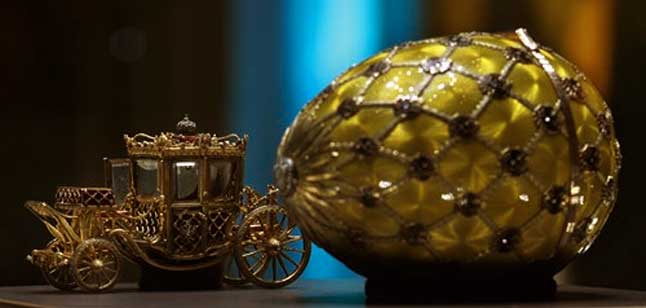Fabergé Egg
Contact
Russian StudiesHumanities Building, Room 209 651-696-6374
651-696-6428 (fax)
davism@macalester.edu
facebook instagram blogspot

There is a small, jeweled egg, which is made of precious metals and hard stones. Silver, gold, copper, nickel, and palladium in addition to sapphires, rubies, diamonds and emeralds are various metals and stones that could be used in this egg. It is decorated with enamel and gems while hanging from a chain. This miniature egg is on a necklace. The egg is one of thousands created by the House of Fabergé between 1885 and 1917. This egg, like many others, was given as a gift on Easter. This originally started when Tsar Alexander III decided to give his wife an egg. Thousands of these small eggs were created, but the most famous Fabergé eggs are larger and were made annually for Alexander III and Nicholas II of Russia.
At the age of 24, Peter Karl Fabergé took over his father’s company, which specialized in jewelry, and was determined to distinguish his family’s name. The exquisite detail of the feathers on the hen inside this egg caught the eye of Tsar Alexander III. In 1885, Fabergé was appointed as Supplier to the Court of His Imperial Majesty. Becoming the Supplier was one of the highest honors that a jeweler could receive. This position involved providing the gift that was to be exchanged when the Tsar went on a visit to another head of state. An example of such gifts is the crystal bed that Russia gave to Persia in the 19th century. It was necessary for the gift to be crafted carefully, ensuring perfection in this work of art. Since this was a position that few jewelers received, there was pressure to make spectacular gifts. Each egg was different. Russian symbols, such as Byzantine crosses and double-headed eagles, are fabricated into Fauxbergé eggs made by Ilya Abelsky. His eggs are miniature Fabergé style eggs. These faux eggs are not an exact replication of Fabergé’s eggs. Fauxbergé eggs do show how Fabergé distinguished his family’s name through the hard work and immense detail that was involved in their creation.
A photograph of the Alexander III Equestrian Fabergé egg shows the superior work done by Fabergé. The twisting of platinum below the egg has fine detail as angels rise up towards the base of the egg and support it. The egg is clear and colorless, made of glass, with small leaves etched into the smooth shell. On top of the egg is a crisscrossing of silver with diamonds placed to draw the viewer’s eyes toward such a lovely piece of artwork. Even more eye catching is the deep royal blue box sitting within the egg, tiny diamonds lying along the top edge and a gold horse standing upon it all. There is a flash of light from the camera centered on the middle of the egg, making the figure within stand out more. The lighting surrounding the egg makes the diamonds sparkle, showing the detail with which Fabergé created his eggs.
The creation of an egg took about one year, a process that had a preliminary period including detailed planning, sketches, and models. Discussions also took place among the goldsmiths, enamellers, jewelers, and other various people who would contribute their abilities toward the final Fabergé egg. Fabergé used the most advanced techniques when creating these eggs, including the invention of new techniques, of which are still unknown, by the craftsmen. He would not be limited by the current 19th century goldsmith technologies to execute his ideas. Faberge used a complicated enameling process that still cannot be repeated today. Being this advanced put Fabergé far ahead of any other competition.
The varying and intricate features that Fabergé eggs had crafted into them are the reason that they were so appealing to many people. Also the combination of small size with elaborate decoration was a part of the appeal. Considering the time that these eggs were being made, from the late 1800s to early 1900s, Fabergé used advanced technologies, still unknown, that were ahead of his time. Smaller eggs worn as necklaces had many details as well but it was the larger eggs that were made specifically for the Tsars that made the Fabergé name famous.
– Julia Huerta, December 2009
Sources
- Proler, Lynette, and Valentin Skurlov. The Fabergé Imperial Easter Eggs. London: Christie, Manson & Woods, Limited, 1997. 90. Print.
- https://www.pbs.org/treasuresoftheworld/faberge/flevel_1/ftimeline.html
- https://www.mieks.com/faberge-en/introduction.htm